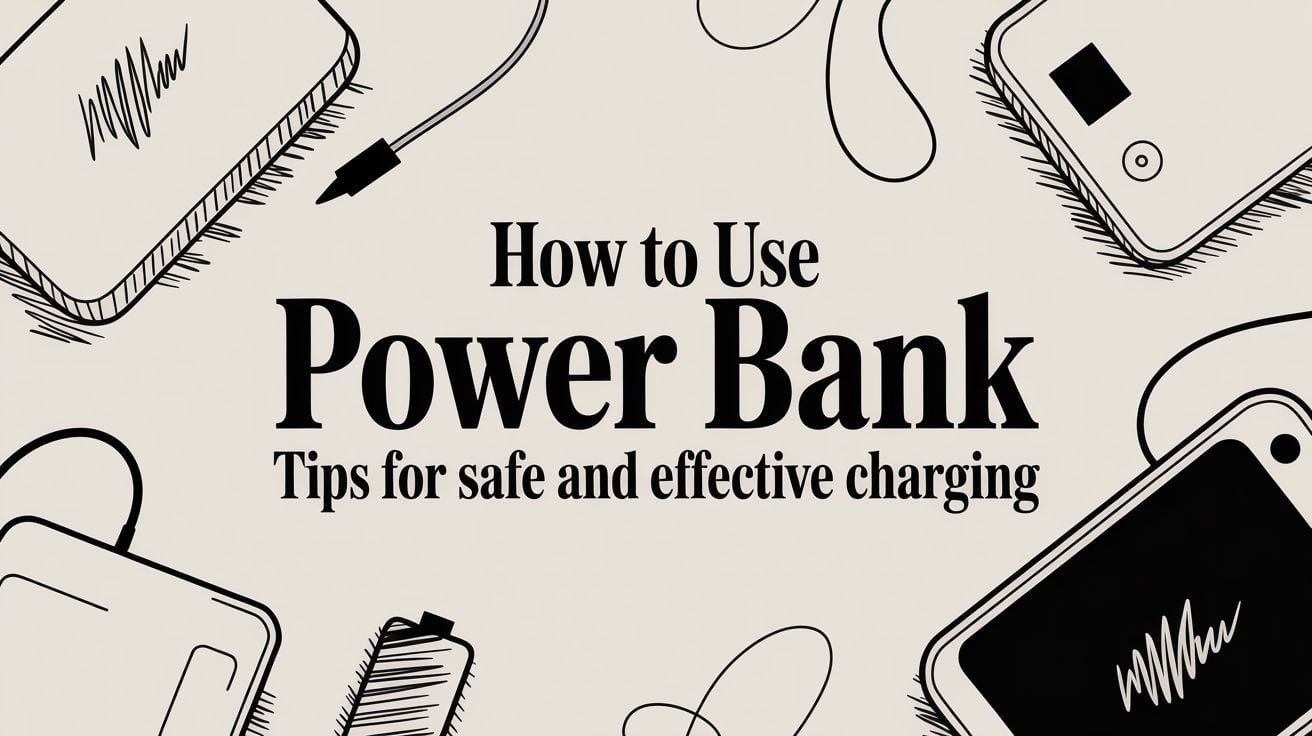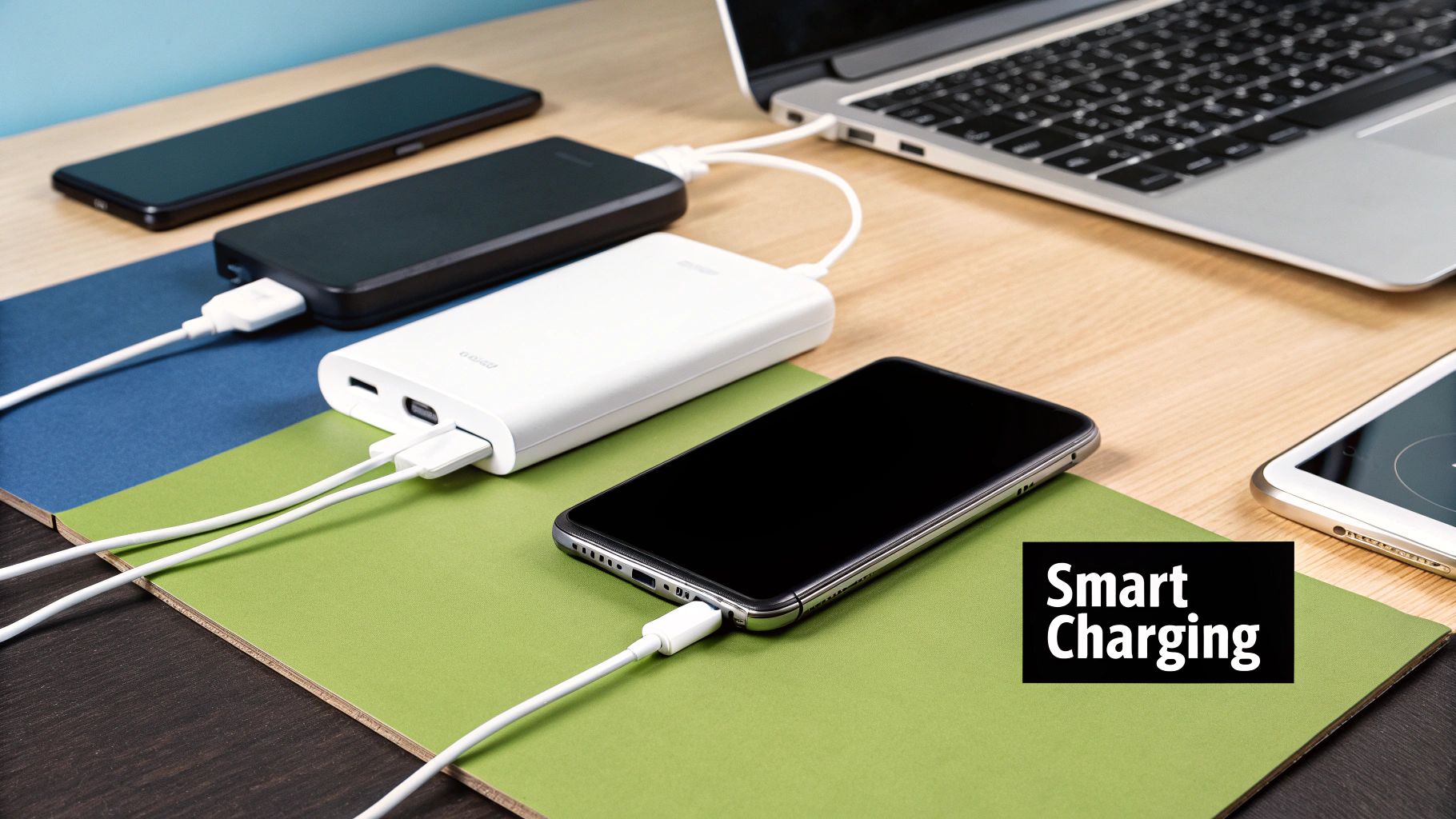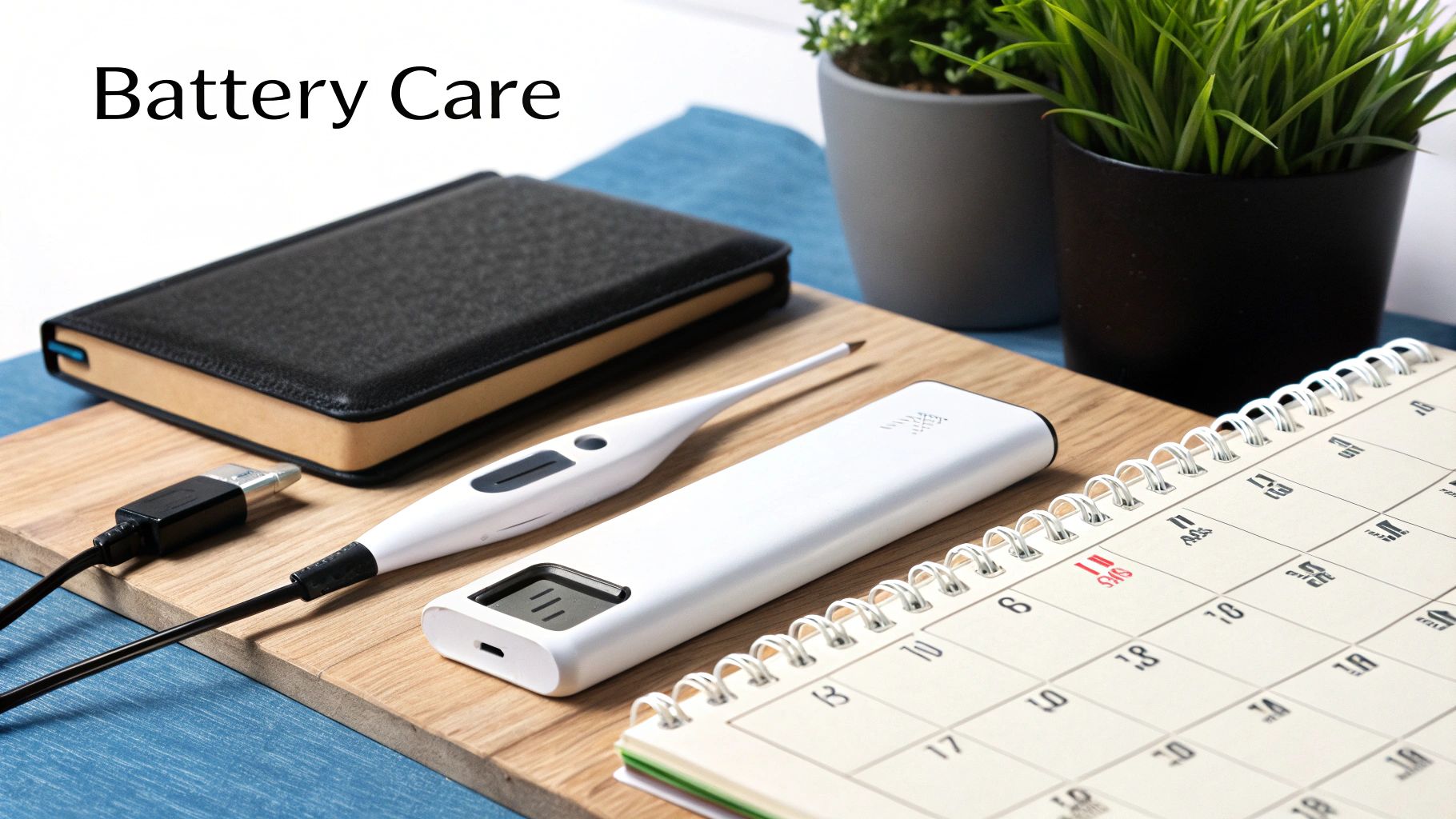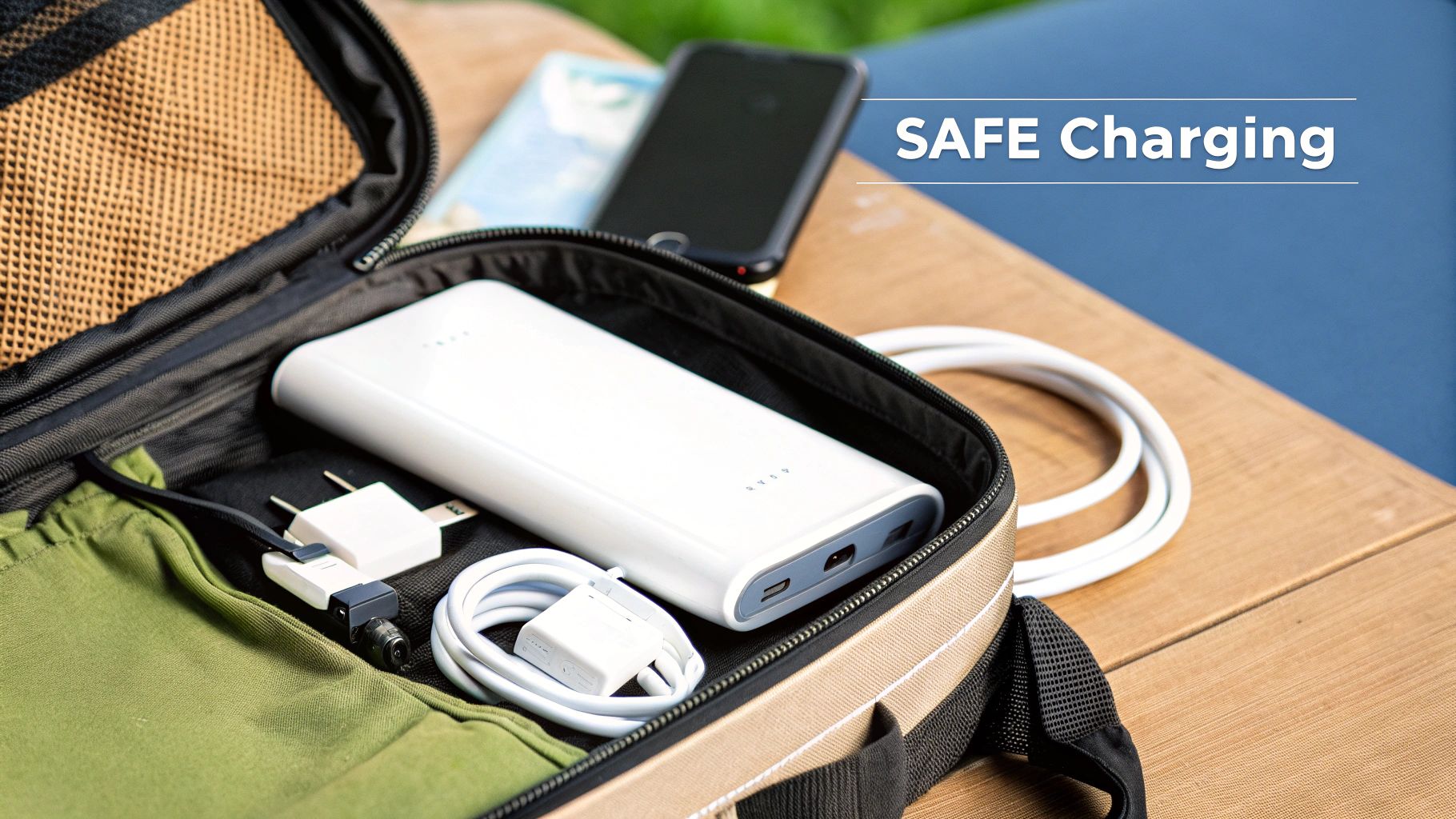
How to Use a Power Bank: A Simple Guide to Charging on the Go
Using a power bank is easy: you charge it up, and then it charges your stuff. First, you'll need to charge the power bank itself using a wall charger. Once it's full, just connect your phone or tablet with the right cable, press the power button, and you're all set.
Getting Started With Your Power Bank
So, you've just unboxed your new portable charger. Before you can start using it on a long travel day or during a busy schedule, there are a couple of quick things to do to get it ready. It’s less about a complicated setup and more about just preparing it to work its best from the very beginning.
It’s no surprise that power banks have become a daily essential. The global market was valued at an incredible USD 12.2 billion in 2024, which just goes to show how much we all depend on our gadgets. You can dig into the numbers and trends over on imarcgroup.com. This massive growth highlights that knowing your way around a power bank isn't just for tech experts anymore—it's a practical life skill.
This quick visual guide breaks down the whole process into three simple stages.
As you can see, it really is as easy as charging it up, checking the power level, and plugging in your device.
First Charge and Basic Functions
The very first thing you should do is give your new power bank a full, uninterrupted charge. Use the cable it came with and plug it into a wall charger—not a laptop, as that can be too slow. Let it sit until all the indicator lights are solid, showing it's at 100%. This first charge is super important because it helps the battery's sensor work correctly, ensuring you get accurate power level readings later on.
Once it's charged, you'll notice it's a pretty simple device. A single press of the power button usually does one of two things: it either wakes the power bank up to start charging a connected device, or it lights up the LED indicators to show you how much juice is left. It’s a handy feature for that quick check before you walk out the door.
Understanding Your Power Bank's Lights and Symbols
Those little blinking lights and symbols on your power bank aren't just for show—they're telling you exactly what's going on. Learning to read them is key to knowing when to recharge the bank or how much power you have left for your devices. Here's a quick guide to what the most common indicators mean.
| Indicator | What It Means | Action to Take |
|---|---|---|
| Solid LED Lights | The power bank is fully charged or is showing its current battery level. | If all lights are solid, it's ready to use. If some are off, that's how much power is left. |
| Blinking LED Lights | The power bank is either charging itself or actively charging another device. | Let it continue charging until the lights turn solid. If it's charging a device, it's working as expected. |
| One Blinking Light | The battery level is very low (usually below 10%). | Time to find an outlet and recharge the power bank as soon as possible. |
| No Lights On | The power bank is off or completely out of battery. | Press the power button once. If nothing happens, it needs to be charged. |
This table should help you quickly figure out what your power bank is trying to tell you, so you're never caught off guard with a dead battery when you need it most.
The Right Way to Charge Everything

How you charge your gear actually matters more than you might think. It’s not just about getting the power flowing—it's about doing it safely and efficiently to protect both your devices and the power bank itself.
Think of it this way: using a tiny, low-power wall plug to charge a massive power bank is like trying to fill a swimming pool with a garden hose. Sure, it’ll get the job done… eventually. But it's painfully slow. You should always try to use a powerful wall charger to fill up your power bank for the best results.
Smart Charging Habits for Your Devices
When you're plugging in your devices, be strategic. Most power banks have multiple charging ports, and they are definitely not all the same. Some are built for power-hungry gadgets like tablets, while others are better for your phone or earbuds.
- High-Power Ports: Look for the ports marked with a higher number (like 2.4A) or wattage. These are your friends for bigger devices like an iPad or even a Nintendo Switch, making sure they charge at a good speed.
- Standard Ports: The lower-power ports (often 1A) are perfect for your smartphone or wireless headphones. Using these for smaller devices prevents putting unnecessary stress on their batteries.
This simple habit of matching the port to the device is a huge part of learning how to use a power bank effectively and will seriously extend the life of your electronics.
Here’s a pro tip: I'd avoid "pass-through charging" whenever possible. That's when you charge a device from the power bank while the power bank itself is plugged in and charging. It creates a lot of extra heat, which is the number one enemy of battery life for both your gear and the bank itself.
This is more relevant than ever. Our reliance on mobile tech is exploding—in the Asia Pacific region, smartphone ownership was 76% in 2022 and is on track to hit 94% by 2030. That trend is fueling the massive need for reliable portable power. You can see more data on this at fortunebusinessinsights.com.
Some of the newer, more powerful power banks can even handle bigger electronics now. If you're curious about juicing up your larger gadgets on the go, check out our guide on how many watts you need to charge a laptop. By building these smart habits, you’ll make sure your gear is always ready when you need it.
Keeping Your Power Bank Healthy for Longer

Think of a good power bank as a long-term travel companion, not something you have to throw out and replace every year. And just like the battery in your phone or laptop, a little bit of care goes a surprisingly long way. Picking up a few simple habits can dramatically improve its health and how well it performs over its lifetime.
The biggest rule is one you already know: keep it away from extreme temperatures. Leaving your power bank to bake in a hot car is a sure way to damage its internal battery. The same thing happens if you leave it out in the freezing cold—that can permanently reduce its total power capacity.
Smart Storage and Usage Habits
One of the most common mistakes I see is people letting a power bank sit completely dead for months. If you only pull it out for the occasional trip, please don't just toss it in a drawer at 0%. The batteries inside really don't like being left completely empty for long periods.
When you're putting it away for a while, the best charge level for storage is right around 50%. This keeps the battery stable and healthy. It's also a good idea to use it at least once every three months—give it a partial charge or use it to top off your phone. This keeps everything in good working order.
There's an old myth that you need to drain batteries completely before recharging. While that was true for old-fashioned batteries, it's actually harmful for the modern batteries in your power bank. Regularly running it down to 0% puts a lot of stress on the battery and will absolutely shorten its lifespan.
For day-to-day use, try to keep the charge level somewhere between 20% and 80%. This is the best range for a long life. Of course, charging it to 100% right before a long flight is perfectly fine when you need every drop of power. Just try not to make it a daily habit. If you're looking to automate this, a hardware battery charge limiter can be a game-changer for managing these levels without you having to think about it.
Key Maintenance Do's and Don'ts
Protect your investment with a few simple practices. It’s the difference between a power bank that lasts for years and one that dies an early death.
- Do: Store it in a cool, dry place. A desk drawer is great; a car's glove compartment is not.
- Don't: Let it die completely. Once you see that last light blinking, it's time to find an outlet.
- Do: Use it occasionally. Even a quick top-up for your phone once a month is better than letting it gather dust.
- Don't: Overcharge it constantly. There's no need to leave it plugged in all day; just unplug it when it’s full to reduce battery stress.
Safe Charging Habits Everyone Should Know

Knowing how to charge your power bank is one thing, but using it safely is just as important. A few smart habits can protect your expensive gear from damage and, just as importantly, make sure you don't run into any trouble with airport security.
Believe it or not, the most common reason for charging problems usually isn't the power bank itself—it's the cable. Using a frayed, cheap, or damaged cable can lead to unstable power and damage your phone. If you ever notice a cable getting unusually hot or see it's worn out, stop using it immediately. It's just not worth the risk.
Spotting a Dangerous Power Bank
Just as you'd check your cables, you need to keep an eye on the physical condition of your power bank. The batteries inside are generally very safe, but they can become a real hazard if they get damaged.
There are a couple of red flags you should never, ever ignore:
- Physical Swelling: If the case of your power bank looks puffy, bloated, or like it's bulging, that’s a clear sign of internal battery failure. This is a serious safety risk.
- Excessive Heat: It’s totally normal for a power bank to get a little warm when it's working hard. However, if it ever gets too hot to comfortably hold, unplug it right away. Let it cool down somewhere safe, away from anything that can catch fire.
A swollen or overheating power bank is a ticking time bomb. Don't try to use it, charge it, or even keep it in your house. The best thing to do is take it to a designated battery recycling center for safe disposal.
While these problems are rare, especially with well-known brands, they show why it pays to be careful. Of course, people have lots of questions about other common practices, and you can learn more from our guide on whether you should charge your phone overnight.
Flying with Your Power Bank
You can absolutely travel by air with a power bank, but you have to follow the rules from the TSA and individual airlines. These aren't just for show—they exist because the batteries can pose a fire risk in the cargo area of a plane.
The main rule is simple: all power banks must be in your carry-on luggage. They are strictly forbidden in checked bags. Period. Most airlines also set a power limit, usually around 100Wh (watt-hours), which covers nearly every power bank you'd buy for personal use. Just toss it in your backpack or purse, and you'll get through security just fine.
Solving Common Power Bank Problems
Even the best power banks can have problems. Before you give up and assume it's dead, a few quick troubleshooting tricks can usually get things working again. More often than not, the issue is something small you can fix yourself in seconds.
One of the most common issues is a power bank that just won't charge your device. The first place I always look? The cable. It's the most likely culprit. Grab a different cable—one you know for sure is working—and see if that does the trick. You’d be surprised how often a bad cable is the real problem.
If a new cable doesn't solve it, the next stop is the charging ports themselves.
Quick Fixes for Unresponsive Chargers
Over time, the charging ports on both your power bank and your phone can get packed with pocket lint, dust, and other debris. This buildup prevents a good connection, and a quick, gentle clean can make all the difference.
- Inspect the Ports: Take a close look inside the USB ports on the power bank and your phone.
- Clean with Care: Grab a wooden or plastic toothpick and gently scrape out any debris you see. Never use anything metal, like a paperclip, as it can easily damage the port.
- A Blast of Air: A can of compressed air is also a great, safe option for clearing out any stubborn dust.
Once you’ve cleaned the ports, try connecting everything again. This simple fix is often all it takes to solve charging problems.
Still nothing? You can try a simple reset. Just take the charging cable, plug one end into the power bank's output port, and loop the other end back into its input port. Hold it for about 10 seconds. This can sometimes reboot the internal system and clear up minor glitches.
Another classic issue is painfully slow charging. If your phone is taking forever to gain any juice, check that you’re plugged into a high-power port on the power bank. These are usually marked with 2.1A or higher. Also, make sure you're using a high-quality cable that’s actually designed for faster charging speeds.
Got Power Bank Questions? We've Got Answers.
We get asked all the time about the dos and don'ts of using power banks, so I want to clear up a few things I see popping up constantly.
One of the biggest questions is whether it's okay to use your phone while it's hooked up to a portable charger. The short answer? Yes, it’s generally fine. Your phone and the power bank are smart enough to manage the power flow and have safety features built in.
That said, using your phone while it charges—especially for something intense like gaming—creates extra heat. And if there's one thing that absolutely destroys a battery's long-term health, it's heat. So, whenever you can, just let it charge in peace.
How Many Charges Will I Actually Get?
This is the classic question. People often think if they have a 10,000mAh power bank and a 5,000mAh phone battery, they'll get two full charges. It just doesn't work that way.
The truth is, you lose a good chunk of energy when power moves from the bank to your phone, mostly as heat. It's never 100% efficient. A realistic rule of thumb is to expect only about 60-70% of the advertised capacity to actually make it into your device.
For example, a 10,000mAh power bank doesn't really give you 10,000mAh of charging power. You're looking at more like 6,500mAh of usable power. If your phone has a 3,250mAh battery, you'll get roughly two full charges out of it. Simple as that.
Knowing this little bit of math helps you pick the right size for your needs. A 10,000mAh unit is usually the sweet spot for daily top-ups. But if you're heading out for a long weekend or need to charge multiple gadgets, grabbing a 20,000mAh model is a much safer bet.
If you're serious about making your batteries last and finally ending the worry about overnight charging, you need to check out Chargie. It’s a smart hardware-and-app system that gives you total control over how you charge, preventing the damage that kills your battery's lifespan. Protect your phone and cut down on e-waste by visiting us at https://chargie.org.

